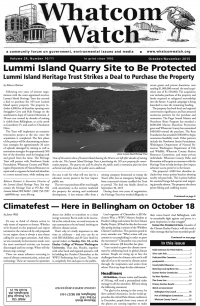To celebrate over 23 years of publishing Whatcom Watch, we will be publishing excerpts from 20 years ago. David M. Laws has been generous enough to volunteer to review the Whatcom Watch for 20 years ago to find suitable material to reprint. The below excerpts are from the November 1995 issue of Whatcom Watch.
Breast Cancer and Environmental Toxins:
We All Live Downwind
by Colleen Kelly
As we move into the 21st Century, it becomes starkly obvious that we live in a poisoned environment. We seem to have lost the right to live in a society where the air we breathe, the water we drink, the food we eat, and the places we work are clean and poison-free.
By the year 2000, according to the American Cancer Society, cancer will overtake heart disease and become the #1 cause of death in the United States. American Cancer Society’s recent statistics from Facts and Figures are harsh: cancer strikes nearly half of all men in the United States (45 percent), and more than every third woman (39 percent). In September, 1994, the National Cancer Institute finally admitted that we are losing the war on cancer despite pumping $30 billion dollars into winning it. What has happened? Where has the money gone and why does cancer continue to claim lives at a rate never before seen in history?
Worldwide statistics show that lung, cervical and breast cancers are the leading cause of cancer death, with breast cancer being by far hte most frequent cancer in women, responsible for 19 percent of female cancers. Each year, breast cancer causes 161,000 deaths in industrialized countries and 147,000 in developing countries.
The United States has the highest incidence rate of breast cancer in the world. Much of the well-publicized rise in breast cancer between 1950 and the present (from 1 in 20 to 1 in 8) has occurred since 1985. Women over 60 show the most dramatic rise, and immigrants to this country quickly assume the statistical risk of those born here.
As far back as 1964, the World Health Organization told us that 80 percent of all cancers were due to synthetic, man-made carcinogens. Now, there is overwhelming evidence that the huge increase in cancer rates is linked to the increased chemical production over the last 100 years. […] Currently, among some industrial workers, the rates of certain types of cancer are up to ten times higher than in the general population. […] Seven out of every ten women that develop breast cancer do not have any of the known or traditionally defined risk factors … This means that 70 percent are told that the source of their cancer is not known.
At the same time, a growing body of evidence indicates that exposure to ionizing radiation and to endocrine disrupting, hormonally-active industrial chemicals play a role in causing breast and other cancers … A second example is estrogen. Numerous petroleum-based compounds — pesticides, auto exhaust, industrial solvents, plastics — mimic estrogen in the body and thus raise the level of bioavailable estrogen, [considered] to be directly linked with breast cancer …. This growing evidence indicates that women are suffering and losing their lives due to avoidable environmental pollution.
Women’s Health Action Network is a Seattle-based environmental justice group concerned about the effects of hazardous chemicals on our health and our children’s health. [We are] calling for the recognition of the existence of a global, environmentally-induced cancer epidemic. We are working for removing from the environment carcinogenic substances which have particularly adverse effects on women and children.
We feel that particular attention in medical research and treatment should be paid to women’s cancers: breast, ovarian, cervical, uterine, and vaginal. Research and remedial action should also focus on the effects of toxic chemicals, nuclear wastes, radiation and pesticides on human health.




























